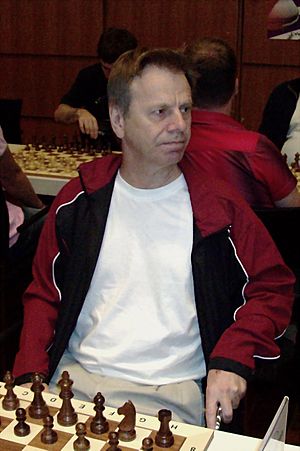Ulf Andersson facts for kids
Quick facts for kids Ulf Andersson |
|
|---|---|

Andersson in 2008
|
|
| Country | Sweden |
| Born | 27 June 1951 Västerås, Sweden |
| Title |
|
| FIDE rating | 2516 (April 2025) |
| Peak rating | 2655 (January 1997) |
| Peak ranking | No. 4 (January 1983) |
Ulf Andersson (born 27 June 1951) is a leading Swedish chess player. FIDE awarded him the International Master title in 1970 and the Grandmaster title in 1972.
Chess career
At his peak, Andersson reached number four on the FIDE rating list. Tournaments which he has won or shared first include the 1969 Swedish Chess Championship, Göteborg 1971, Dortmund 1973, Camagüey 1974, Cienfuegos 1975, Belgrade 1977, Buenos Aires 1978, Hastings 1978–79, Phillips & Drew 1980, Johannesburg 1981, Phillips & Drew 1982, Turin 1982, Wijk aan Zee 1983, Reggio Emilia 1985, Rome 1985, and Rome 1986. Andersson drew a six-game match against former world champion Mikhail Tal in 1983, and played top board in the second USSR versus The Rest of The World Match in 1984. He led the Swedish Chess Olympiad Team during the 1970s and 1980s, and reached his best personal result in the 23rd Chess Olympiad in Buenos Aires 1978, where he finished in third place on first board, after Viktor Korchnoi and Orestes Rodríguez Vargas. Now in his seventies, Andersson still participates in tournaments from time to time.
Playing style
Andersson is a very solid positional player. He draws a high percentage of his games against fellow grandmasters (Kaufeld & Kern 2011, p. 12). He is renowned as a great player of endgames, especially rook endgames, and is famous for winning seemingly "unwinnable" endgames, often in very long games (Kaufeld & Kern 2011, p. 167). Jacob Aagaard wrote about Andersson in his book Excelling at Chess, stating: "He is a very prophylactic player, seeing all kinds of tactics well in advance and avoiding pitfalls with great skill." Chess writer Dennis Monokroussos once remarked of Andersson's style,
For most of us, if we're playing a peer and major exchanges occur, a quick draw is the likely result ... for Andersson ... exchanges [are] often not the prelude to a quick draw but the signal that it [is] time for his opponent to start suffering.
Correspondence play
Andersson began playing correspondence chess in 1995, and became a correspondence chess grandmaster that same year. Very few players in history have been as successful as Andersson at both forms of chess. For Ulf, who struggled to keep his nerves in check during over-the-board chess and often avoided lines with any risk of loss, it was a relief to have ample time to consider the subtle nuances of each move. His correspondence games tend to be very tactical, which contrasts sharply with his style of play over the board.
While in the process of winning in the 'Norwegian Postal Chess Federation – 50 Years' tournament, he attained the highest provisional rating in ICCF history, with a score of 2821 on the 1998 list. After earning an established rating in 2002, he finally reached the top of the official rating list (Kaufeld & Kern 2011, p. 11).
With computer assistance slowly taking over the world of correspondence chess, Ulf was one of the few players still competing without it in the early 2000s. However, as postal play gave way to faster-paced email tournaments, he found himself having to send moves before feeling satisfied with them to avoid losing on time. Declining a wildcard for the world championship, he quietly finished his last correspondence game in 2003, reflecting in retrospect that he found it too demanding. Despite the changing times he lost only a single official game throughout his correspondence chess career, to Hans-Marcus Elwert in the Millennium Email Chess Tournament, and is as of 2024 still the highest rated inactive player on the ICCF rating list.
Notable games
| This section uses algebraic notation to describe chess moves. |
In the following game, using the "hedgehog" formation he in part originated (characterized by a half-open c-file and pawns on a6, b6, d6, and e6, knights on d7 and f6, bishops on b7 and e7, a rook on c8, and kingside castling), Andersson inflicts upon Anatoly Karpov the latter's first loss as world champion:
| h | g | f | e | d | c | b | a | ||
| 1 |

|
1 | |||||||
| 2 | 2 | ||||||||
| 3 | 3 | ||||||||
| 4 | 4 | ||||||||
| 5 | 5 | ||||||||
| 6 | 6 | ||||||||
| 7 | 7 | ||||||||
| 8 | 8 | ||||||||
| h | g | f | e | d | c | b | a | ||
See also
 In Spanish: Ulf Andersson para niños
In Spanish: Ulf Andersson para niños

